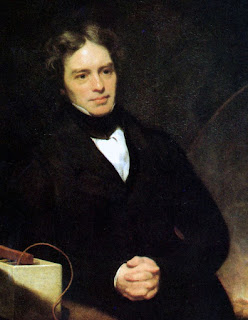Michael Faraday: Inventor of the Electric Motor
Michael Faraday was a British physicist and chemist who is best known for his discoveries of electromagnetic induction and of the laws of electrolysis. His biggest breakthrough in electricity was his invention of the electric motor.
Born in 1791 to a poor family in London, Faraday was extremely curious and was questioning everything. He always felt an urgent need to know more. So at age 13, he became an errand boy for a bookbinding shop in London.
He read every book that he bound and decided that one day he would write a book of his own. He became interested in the concept of energy, specifically force. Because of his early reading and experiments with the idea of force, he was able to make important discoveries in electricity later in life. He eventually became a chemist and physicist.
Faraday built two devices to produce what he called electromagnetic rotation. That is a continuous circular motion from the circular magnetic force around a wire. Ten years later, in 1831, he began his great series of experiments in which he discovered electromagnetic induction. These experiments would form the basis of modern electromagnetic technology.
In 1831, using his "induction ring", Faraday made one of his greatest discoveries. Electromagnetic induction is the "induction" or generation of electricity in a wire by means of the electromagnetic effect of a current in another wire.
The induction ring was the first electric transformer.
In a second series of experiments in September he discovered magneto-electric induction: the production of a steady electric current. To do this, Faraday attached two wires through a sliding contact to a copper disc. By rotating the disc between the poles of a horseshoe magnet, he obtained a continuous direct current.
This was the first generator. From his experiments came devices that led to the modern electric motor, generator and transformer.
Faraday continued his electrical experiments. In 1832, he proved that the electricity induced from a magnet, voltaic electricity produced by a battery and static electricity were all the same. He also did significant work in electrochemistry, stating the First and Second Laws of Electrolysis. This laid the foundation for electrochemistry, another great modern industry.
Faraday passed away in his home in Hampton Court on August 25th, 1867 at the age of 75. He was buried at Highgate Cemetery in North London. A memorial plaque was set up in his honor at Westminster Abbey Church, near Isaac Newton's burial spot.
Faraday's influence extended to a great many leading scientists. Albert Einstein was known to have had a portrait of Faraday on his wall in his study, where it hung alongside pictures of legendary physicists Sir Isaac Newton and James Clerk Maxwell.
Among those who praised his achievements were Earnest Rutherford, the father of nuclear physics. Of Faraday he once stated:
Born in 1791 to a poor family in London, Faraday was extremely curious and was questioning everything. He always felt an urgent need to know more. So at age 13, he became an errand boy for a bookbinding shop in London.
He read every book that he bound and decided that one day he would write a book of his own. He became interested in the concept of energy, specifically force. Because of his early reading and experiments with the idea of force, he was able to make important discoveries in electricity later in life. He eventually became a chemist and physicist.
Faraday built two devices to produce what he called electromagnetic rotation. That is a continuous circular motion from the circular magnetic force around a wire. Ten years later, in 1831, he began his great series of experiments in which he discovered electromagnetic induction. These experiments would form the basis of modern electromagnetic technology.
In 1831, using his "induction ring", Faraday made one of his greatest discoveries. Electromagnetic induction is the "induction" or generation of electricity in a wire by means of the electromagnetic effect of a current in another wire.
The induction ring was the first electric transformer.
In a second series of experiments in September he discovered magneto-electric induction: the production of a steady electric current. To do this, Faraday attached two wires through a sliding contact to a copper disc. By rotating the disc between the poles of a horseshoe magnet, he obtained a continuous direct current.
This was the first generator. From his experiments came devices that led to the modern electric motor, generator and transformer.
Faraday continued his electrical experiments. In 1832, he proved that the electricity induced from a magnet, voltaic electricity produced by a battery and static electricity were all the same. He also did significant work in electrochemistry, stating the First and Second Laws of Electrolysis. This laid the foundation for electrochemistry, another great modern industry.
Faraday passed away in his home in Hampton Court on August 25th, 1867 at the age of 75. He was buried at Highgate Cemetery in North London. A memorial plaque was set up in his honor at Westminster Abbey Church, near Isaac Newton's burial spot.
Faraday's influence extended to a great many leading scientists. Albert Einstein was known to have had a portrait of Faraday on his wall in his study, where it hung alongside pictures of legendary physicists Sir Isaac Newton and James Clerk Maxwell.
Among those who praised his achievements were Earnest Rutherford, the father of nuclear physics. Of Faraday he once stated:
"When we consider the magnitude and extent of his discoveries and their influence on the progress of science and of industry, there is no honour too great to pay to the memory of Faraday, one of the greatest scientific discoverers of all time."
Posted By ZaptaiLo.BlogSpot.Com









Post a Comment